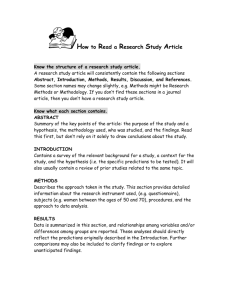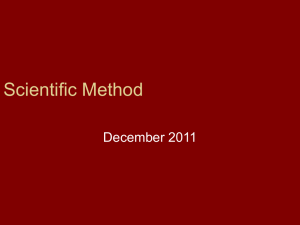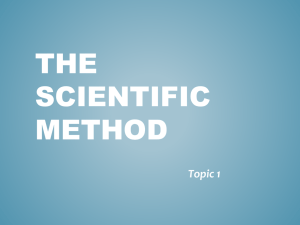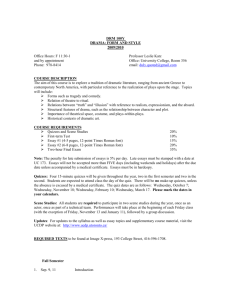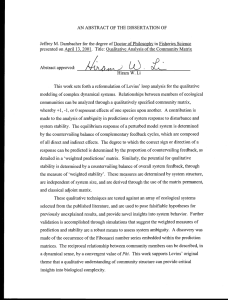Key terminology related to "the scientific method"
advertisement
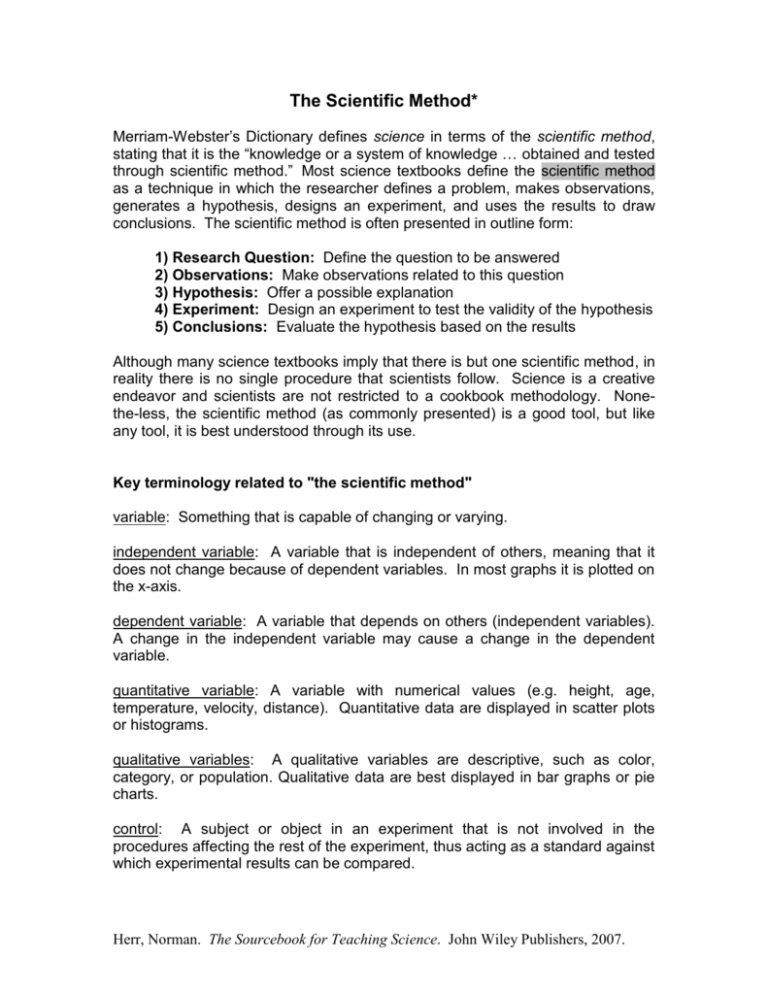
The Scientific Method* Merriam-Webster’s Dictionary defines science in terms of the scientific method, stating that it is the “knowledge or a system of knowledge … obtained and tested through scientific method.” Most science textbooks define the scientific method as a technique in which the researcher defines a problem, makes observations, generates a hypothesis, designs an experiment, and uses the results to draw conclusions. The scientific method is often presented in outline form: 1) Research Question: Define the question to be answered 2) Observations: Make observations related to this question 3) Hypothesis: Offer a possible explanation 4) Experiment: Design an experiment to test the validity of the hypothesis 5) Conclusions: Evaluate the hypothesis based on the results Although many science textbooks imply that there is but one scientific method, in reality there is no single procedure that scientists follow. Science is a creative endeavor and scientists are not restricted to a cookbook methodology. Nonethe-less, the scientific method (as commonly presented) is a good tool, but like any tool, it is best understood through its use. Key terminology related to "the scientific method" variable: Something that is capable of changing or varying. independent variable: A variable that is independent of others, meaning that it does not change because of dependent variables. In most graphs it is plotted on the x-axis. dependent variable: A variable that depends on others (independent variables). A change in the independent variable may cause a change in the dependent variable. quantitative variable: A variable with numerical values (e.g. height, age, temperature, velocity, distance). Quantitative data are displayed in scatter plots or histograms. qualitative variables: A qualitative variables are descriptive, such as color, category, or population. Qualitative data are best displayed in bar graphs or pie charts. control: A subject or object in an experiment that is not involved in the procedures affecting the rest of the experiment, thus acting as a standard against which experimental results can be compared. Herr, Norman. The Sourcebook for Teaching Science. John Wiley Publishers, 2007. constants: Factors that are held constant during an experiment. To determine the effect of an independent variable on a dependent variable, all other potential factors must be held constant. Observations vs. Inference Many people confuse observations with inferences. Observations is a record resulting from the study of an event or object, whereas an inference is a conclusion that is drawn from evidence based upon observations. Note that observations do not need to be necessarily visual! We often rely on detection mechanisms and indirect records, for example in the study of atoms Ernest Rutherford shot particles through thin foils and detected that some bounced back. He made an inference using this observation about the structure of atoms which we use until this day. Models in Physics Since the physical world is very complex, physicists often use models. A model is simplified depiction of reality that is used to isolate a particular feature about a phenomena. From simple models complexity can be added to explain the more detailed features, it is the job of a physicists (and engineers and scientists) to decide what parts are relevant and which can be disregarded or approximated. This has led to various jokes, including the phrase “consider a spherical cow” to show how physicists simplify the real world. OK, it's not a great joke, it is the sort of joke that is only funny to physics students since a common feature of physics problems is to begin by listing assumptions which are often unrealistic. In reality a spherical cow would not be such a bad approximation if you want to obtain the volume occupied by a herb, for example. The Best Models Make Predictions There are many models that can explain physical phenomena, but the best models make predictions. Ptolemy was able to explain the motion of planets using an Earth-centered model that was incredibly accurate and it stood unchallenged for more than a thousand years, yet it was an incorrect depiction of reality! The best models make predictions, Einstein’s General Theory of Relativity for example, was not widely accepted until one of its predictions was verified. It predicted that light from a star close to the line of sight of the Sun would bend due to the Sun’s gravity, this was confirmed during a solar eclipse in 1919. Herr, Norman. The Sourcebook for Teaching Science. John Wiley Publishers, 2007.
